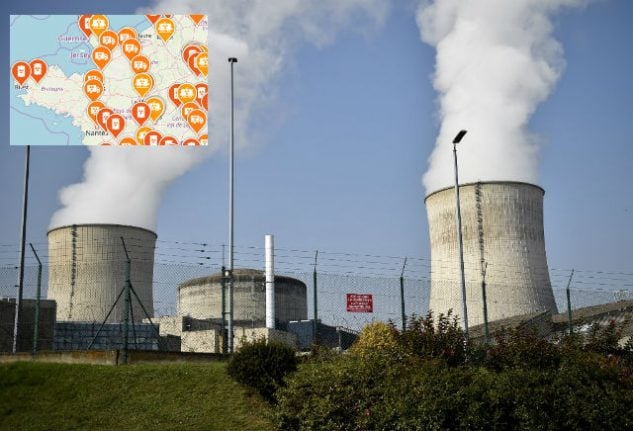Map: Greenpeace
ENVIRONMENT
Map: These are the places in France with the highest levels of nuclear waste
Greenpeace has come up with a map showing exactly where levels of nuclear waste are highest in France. Find out if your area is affected.
Published: 28 May 2019 10:52 CEST

Photo: AFP/Greenpeace
Sixty years of nuclear plants in France and 58 of them in total… but where does the waste end up?
Well, now we can find out, thanks to NGO Greenpeace which has come up with an interactive map showing the locations of the 70 main storage sites and the routes used to transport nuclear waste in France.
France's National Agency for Radioactive Waste Management (ANDRA) is set to make a similar map available to the French public however Yannick Rousselet, who focuses on nuclear energy at Greenpeace, argues that the agency is “mixing apples and oranges” by including, for example, medical waste.
The NGO's map, first published in Le Parisien, is an attempt on the part of Greenpeace to “set the record straight”.
The Greenpeace map not only shows where nuclear waste is at its highest in France but it also indicates the major roads and railways used to transport it.
These transport routes represent “very important safety issues”, according to the Nuclear Safety Authority (ASN).
In total, 1.6 million cubic meters of radioactive waste, the equivalent of nearly 640 Olympic swimming pools, have accumulated in France, according to Greenpeace.
A total of 60 percent of this waste comes directly from the electricity production at nuclear power plants, ANDRA said at the end of 2017.
French power giant EDF says that currently four percent of nuclear waste is destroyed and stored on the sites of power plants, waiting to be buried 500 metres underground at a highly controversial site in Bure in the Grand Est region – yet to be completed – which some have dubbed an “underground Chernobyl”.
The French nuclear industry argues that the remaining 96 percent of uranium used in power plants can be upgraded and injected back into the reactors. But in fact, only one percent of the fuel is currently being recycled in 22 of the 58 reactors run by EDF.
That still leaves 95 percent of all waste – several tens of thousands of tonnes – in storage, with EDF saying they plan to inject back into the fuel cycle in the future.
A public debate on nuclear waste was launched in April 2019, as part of the National Plan for the Management of Radioactive Materials and Waste and will continue until September 25th, with dozens of public meetings expected to be held during that time across France.
In November last year, French President Emmanuel Macron said that France would shut down 14 of the country's 58 nuclear reactors currently in operation by 2035, of which between four and six will be closed by 2030.
The total includes the previously announced shutdown of France's two oldest reactors in Fessenheim, eastern France, which Macron said was now set for summer 2020.
He also announced that France would close its remaining four coal-fired power plants by 2022 as part of the country's anti-pollution efforts.
Url copied to clipboard!


 Please whitelist us to continue reading.
Please whitelist us to continue reading.
Member comments